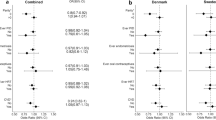Abstract
Objective: We sought to evaluate the association between ovarian cancer risk and use of aspirin and nonsteroidal anti-inflammatories. Methods: We prospectively assessed use of aspirin, nonsteroidal anti-inflammatories (NSAIDs), and acetaminophen use in relation to ovarian cancer risk among 76,821 participants in the Nurses' Health Study who had no history of cancer other than non-melanoma skin cancer. Women reported known and suspected ovarian cancer risk factors in biennial mailed questionnaires from 1976 to 1996, along with new diagnoses of ovarian cancer. Aspirin use was assessed in 1980, 1982, 1984, and 1988–1994. We assessed NSAID use in 1980, and both NSAID and acetaminophen use in 1990, 1992, and 1994. During 16 years of follow-up and 1,222,412 person-years, 333 cases of invasive epithelial ovarian cancer were confirmed. We used pooled logistic regression to control for age, body mass index, oral contraceptive use, smoking history, parity, postmenopausal hormone use, tubal ligation, and other potential ovarian cancer risk factors. Results: Aspirin use was not associated with ovarian cancer risk overall (RR for users compared with nonusers, 1.00, 95% confidence interval (CI 0.80–1.25). We found no association between aspirin dose (in number of weekly tablets) and ovarian cancer risk (RR for those taking 15 or more tablets weekly compared with nonusers, 0.98, 95% CI 0.63–1.52). Similarly, duration of aspirin use was not associated with risk (RR for aspirin use of 20 or more years, 0.99, 95% CI 0.69–1.43). In separate models assessing the relation between NSAID use and ovarian cancer risk we found a 40% reduction in risk among NSAID users versus nonusers (RR 0.60, 95% CI 0.38–0.95). However, when we examined this relationship in terms of days of NSAID use per month, we did not observe a dose–response with increasing NSAID use. Conclusions: We observed no association between aspirin use, dose, or duration and epithelial ovarian cancer risk. Although we found a modest reduction in risk associated with NSAID use, there was no dose–effect.
Similar content being viewed by others
References
American Cancer Society. Cancer Statistics, www.cancer.org. Atlanta; 2001.
Risch HA (1998) Hormonal etiology of epithelial ovarian cancer, with a hypothesis concerning the role of androgens and progesterone. J Natl Cancer Inst 90: 1774-1786.
Casagrande JT, Louie EW, Pike MC, Roy S, Ross RK, Henderson BE (1979) ''Incessant ovulation'' and ovarian cancer. Lancet 2: 170-173.
Cramer DW, Welch WR (1983) Determinants of ovarian cancer risk. II. Inferences regarding pathogenesis. J Natl Cancer Inst 71: 717-721.
Ness RB, Cottreau C (1999) Possible role of ovarian epithelial inflammation in ovarian cancer. J Natl Cancer Inst 91: 1459-1467.
Beral V, Hermon C, Kay C, Hannaford P, Darby S, Reeves G (1999) Mortality associated with oral contraceptive use: 25 year follow up of cohort of 46,000 women from Royal College of General Practitioners' oral contraception study. BMJ 318: 96-100.
Cancer and Steroid Hormone Study (1987) The reduction in risk of ovarian cancer associated with oral-contraceptive use. Centers for Disease Control Cancer and Steroid Hormone Study. N Engl J Med 316: 650-655.
Hankinson SE, Colditz GA, Hunter DJ, Spencer TL, Rosner B, Stampfer MJ (1992) A quantitative assessment of oral contraceptive use and risk of ovarian cancer. Obstet Gynecol 80: 708-714.
Hankinson SE, Colditz GA, Hunter DJ, et al. (1995) A prospective study of reproductive factors and risk of epithelial ovarian cancer. Cancer 76: 284-290.
Risch HA, Weiss NS, Lyon JL, Daling JR, Liff JM (1983) Events of reproductive life and the incidence of epithelial ovarian cancer. Am J Epidemiol 117: 128-139.
Rosenblatt KA, Thomas DB (1993) Lactation and the risk of epithelial ovarian cancer. The WHO Collaborative Study of Neoplasia and Steroid Contraceptives. Int J Epidemiol 22: 192-197.
Whittemore AS, Harris R, Itnyre J (1992) Characteristics relating to ovarian cancer risk: collaborative analysis of 12 US case-control studies. II. Invasive epithelial ovarian cancers in white women. NSAIDs and ovarian cancer 541 Collaborative Ovarian Cancer Group. Am J Epidemiol 136: 1184-1203.
Cramer DW, Welch WR, Scully RE, Wojciechowski CA (1982) Ovarian cancer and talc: a case-control study. Cancer 50: 372-376.
Harlow BL, Cramer DW, Bell DA, Welch WR (1992) Perineal exposure to talc and ovarian cancer risk. Obstet Gynecol 80: 19-26.
Gertig DM, Hunter DJ, Cramer DW, et al. (2000) Prospective study of talc use and ovarian cancer. J Natl Cancer Inst 92: 249-252.
Hankinson SE, Hunter DJ, Colditz GA, et al. (1993) Tubal ligation, hysterectomy, and risk of ovarian cancer. JAMA 270: 2813-2818.
Whittemore AS, Wu ML, Paffenbarger RS, et al. (1988) Personal and environmental characteristics related to epithelial ovarian cancer. II. Exposures to talcumpowder, tobacco, alcohol, and coffee. Am J Epidemiol 128: 1228-1240.
Risch HA, Marrett LD, Howe GR (1994) Parity, contraception, infertility, and the risk of epithelial ovarian cancer. Am J Epidemiol 140: 585-597.
Rosenberg L, Palmer JR, Rao RS, et al. (2000) A case-control study of analgesic use and ovarian cancer [In process citation]. Cancer Epidemiol Biomarkers Prev 9: 933-937.
Tavani A, Gallus S, La Vecchia C, Conti E, Montella M, Franceschi S (2000) Aspirin and ovarian cancer: an Italian case-control study. Ann Oncol 11: 1171-1173.
Cramer DW, Harlow BL, Titus-Ernstoff L, Bohlke K, Welch WR, Greenberg ER (1998) Over-the-counter analgesics and risk of ovarian cancer. Lancet 351: 104-107.
Moysich KB, Mettlin C, Piver MS, Natarajan N, Menezes RJ, Swede H (2001) Regular use of analgesic drugs and ovarian cancer risk. Cancer Epidemiol Biomarkers Prev 10: 903-906.
Stampfer MJ, Willett WC, Speizer FE, et al. (1984) Test of the National Death Index. Am J Epidemiol 119: 837-839.
Manson JE, Stampfer MJ, Colditz GA, et al. (1991) A prospective study of aspirin use and primary prevention of cardiovascular disease in women. JAMA 266: 521-527.
Willett WC, Sampson L, Stampfer MJ, et al. Reproducibility and validity of a semiquantitative food frequency questionnaire. Am J Epidemiol 122: 51-65.
Willett WC, Sampson L, Browne ML, et al. (1988) The use of a self-administered questionnaire to assess diet four years in the past. Am J Epidemiol 127: 188-199.
Colditz GA, Martin P, Stampfer MJ, et al. (1986) Validation of questionnaire information on risk factors and disease outcomes in a prospective cohort study of women. Am J Epidemiol 123: 894-900.
Salvini S, Hunter DJ, Sampson L, et al. (1989) Food-based validation of a dietary questionnaire: the effects of week-to-week variation in food consumption. Int J Epidemiol 18: 858-867.
D'Agostino RB, Lee ML, Balanger AJ, Cupples LA, Anderson K, Kannel WB (1989) Relation of pooled logistic regression to time dependent Cox regression analysis: the Framingham Heart Study. Stat Med 9: 1501-1515.
Rodriguez C, Henley SJ, Calle EE, Thun MJ (1998) Paracetamol and risk of ovarian cancer mortality in a prospective study of women in the USA. Lancet 352: 1354-1355.
Author information
Authors and Affiliations
Rights and permissions
About this article
Cite this article
Fairfield, K.M., Hunter, D.J., Fuchs, C.S. et al. Aspirin, other NSAIDs, and ovarian cancer risk (United States). Cancer Causes Control 13, 535–542 (2002). https://doi.org/10.1023/A:1016380917625
Issue Date:
DOI: https://doi.org/10.1023/A:1016380917625




